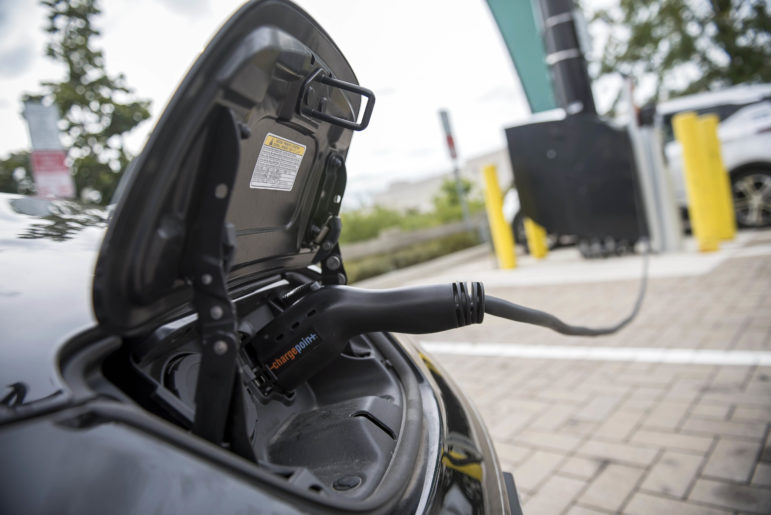‘If we don’t get public charging infrastructure right, our national push to transition away from conventional cars will quickly fizzle.’

Ed Reed/Mayoral Photography Office
An electric vehicle (EV) charging station in Brooklyn.Just one in 50. That’s how many electric cars were sold in the U.S. last year.
President Joe Biden has set a target of electric vehicles (EVs) making up half of all passenger car sales by 2030. But if we don’t get public charging infrastructure right, our national push to transition away from conventional cars will quickly fizzle.
With all the new chargers being installed across the country, you might think we were moving in the right direction. Sadly, we’re spending precious time and billions of dollars in public investment on solutions that are not only wasteful, they’re locking us into a future where owning an EV remains less convenient than owning a conventional car.
We need a national reboot that builds the kind of infrastructure drivers would actually need if half of all cars were converted to EVs. It has to be fast, seamless and flexible for the consumer. It has to be capable of efficiently keeping large fleets of everything from car services to delivery vehicles charged and on the road when they need to be.
And it has to encompass the needs of dense cities like New York.
Our current shortcomings trace back to the California origins of the electric car movement. Our entire national approach to infrastructure and public subsidies has targeted this early adopting, largely suburban population, leaving out huge swaths of the country that would benefit from EVs.
The single biggest piece of our public charging infrastructure—80 percent of it—is made of up “Level 2” chargers meant to charge overnight in places like home garages, promising the ability to charge a vehicle enough to drive a couple hundred miles in up to eight hours. As any EV driver will tell you, advertised charging times at public sites are often a small fraction of how long it takes in the real world.
 CityViews are readers’ opinions, not those of City Limits. Add your voice today!
CityViews are readers’ opinions, not those of City Limits. Add your voice today!
The problem with basing our national network around so many Level 2s and other inadequate equipment is that they will never be fast or flexible enough for a vast array of common uses, especially in cities where people don’t have private parking spaces, let alone their own garage.
This emerging slow-charging landscape isn’t driven by consumer demand but by subsidies from governments and private sector utilities. Those subsidies tilt towards slower and cheaper equipment for which they cover most or all of the installation cost (and a healthy margin for equipment manufacturers and installers), whereas they cover just a portion of the costs of true fast-charging technology that can deliver a charge in minutes.
I ran into these shortcomings firsthand when my company, Gravity Inc, began laying plans to launch a fleet of all-electric yellow taxis in New York with the goal of reviving the iconic NYC taxi brand. While existing infrastructure makes individual EV ownership in cities difficult, I found it made sustainable EV fleet operations impossible. Spending hours charging was out of the question.
We got into the world of infrastructure to solve our own charging problem and found a model that would solve some of the industry’s biggest challenges. When our Midtown Manhattan facility opens this fall, we’ll meet and beat the best-in-class experience that Tesla’s Level 3 Superchargers provide for their customers, built for compatibility with the full universe of EV makes and models, all without requiring a trek to an out of the way location.
Our solution is sized for fast charging that fits indoor parking spaces rather than sprawling suburban lots. The ability to charge in 20 to 30 minutes indoors is new to our industry.
And while most garages install a plug or two, we plan to build toward dozens of facilities with dozens of charging spaces, a generational leap ahead of the current strategy of installing a few slow chargers and calling it enough.
Gravity and our partners are breaking new ground on our own, but we need government to take up this approach if we’re really going to rapidly scale national EV infrastructure to serve half of all new cars.
We need a sober accounting of the billions already spent on our nation’s charging infrastructure that examines the dissatisfaction drivers have with current charging options. Let’s look at how often the current equipment in the field is actually being used, what the clear return on investment is, and whether the speeds we expect are actually being delivered.
The window to get it right is short. The day will come when public funds run out.
All charging isn’t equal, so let’s put this nation’s dollars, space and energy into solutions that actually make owning an EV more convenient than owning a conventional car.
If we do this at scale, we won’t just meet President Biden’s 50 percent goal. We’ll easily surpass it.
Moshe Cohen is the Founder and CEO of Gravity, Inc and a former finance and economics professor at Columbia Business School.








One thought on “Opinion: When It Comes to Electric Cars, All Charging is Not Equal”
Thanks for sharing this post!